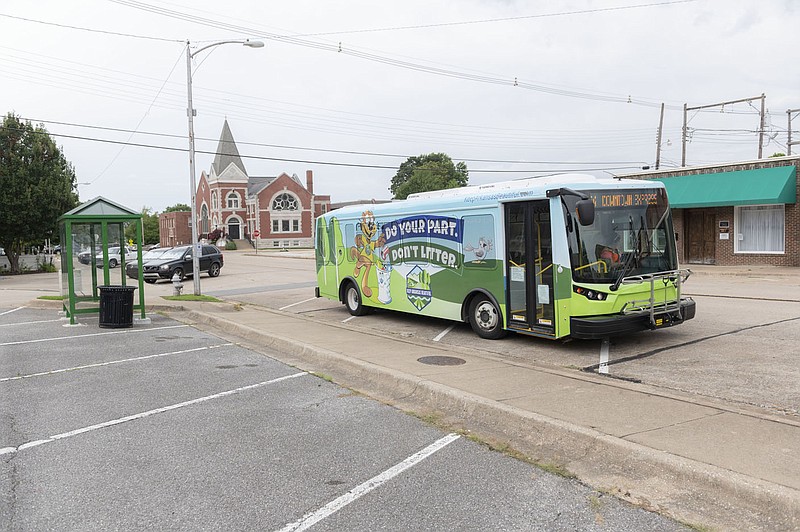ROGERS -- Ozark Regional Transit is making changes this week in Rogers aimed at improving public transit service.
"We are working with the city of Rogers to maximize the number of service hours within the city," said Joel Gardner, executive director of Ozark Regional Transit. "By making these changes, ORT and the city believe we can better serve the residents and their transportation needs."
More stops, better coordination with the on-demand transit service and longer hours will be offered starting Monday. On-demand transit is an application-based, real-time route service similar to ride hailing apps.
On-demand is proving to be a more flexible option for commuters in Rogers, so the transit system is dedicating a second bus to the service, according to a news release.
On-demand transit has 112 bus stops available, with more used when needed, according to Ozark Regional. Ridership, ease of use and public feedback are constantly reviewed and improvements will be made if money becomes available, transit officials said.
Mayor Greg Hines said he's excited about the changes.
"The public demand for the on-demand transit has increased substantially since our initial announcement of the service and surpassed the public demand for the fixed route," Hines said. "This change will allow us to still meet the needs of those who preferred the fixed route, while also giving us more flexibility to add more stops and save time for passengers."
Daily hours of operation are being extended to 7 a.m. until 6:30 p.m. Monday through Friday. Current service is 7 a.m. to 5:30 p.m.
Route 54, which is a standard fixed route, was discontinued Friday to allow for the added on-demand service. Both buses will use every stop that was on the route.
Route 54 connected downtown to the Pinnacle Hills area. It starts at South Second Street and West Elm Street, proceeds south and west via Eighth Street, New Hope Road, South Hampton Place, South Bellview Road, South Promenade, West Pauline Whitaker Road, South Pinnacle Hills Parkway and ends at JB Hunt Towers along South JB Hunt Drive.
In April, about four people a day were riding on Route 54 while about 14 per day were using the on-demand service.
Tim Conklin, assistant director at the Northwest Arkansas Regional Planning Commission, said Rogers was the first city in the region to have on-demand transit as an alternative to fixed-route service, and the only city that was using both prior to covid-19.
Conklin said the changes correlate to "mobility zones," as outlined in the draft of the region's new 10-year Transit Development Plan.
Mobility zones are geographical areas recommended to be connected to the fixed-route system with demand response service, Conklin said. That allows for unproductive routes in high-demand areas to maintain service coverage, but in a more cost-effective manner.
In typical fixed-route service, the bus travels along the same path regardless of the conditions, such as heavy traffic, accidents or construction, according to Gardner. The on-demand model allows the bus driver to use any path to get from point A to point B, avoiding known obstacles.
In fixed-route service, if a passenger is at the Rogers Police Department and wants to go downtown, but the bus is going uptown, the rider has two choices: either get on the bus and go uptown and stay on it until it goes downtown or wait until the bus turns around, comes back to the stop and get on it to go downtown, Gardner said.
In the on-demand model, the rider can select a pickup location and drop off location and the bus driver can turn around at the nearest safe place in the route and take the passenger directly from the police department to his downtown stop.
The on-demand software was created by Pantonium, a Canadian company, and was first rolled out in Belleville, Ontario.
Three cities in the region have gone fare-free. Rogers and Springdale early this year joined Fayetteville in offering free fares on public transit buses.
Rogers' contribution this year to Regional Transit is $467,670. The increase of $267,670 from 2019 helps pay for more routes and the free fares.
For 2020, Springdale is paying $280,000 more than in 2019, for a total of $361,710. The city has three fixed routes.
Fayetteville, which went to free fares in 2018, contributed $532,228 to the system in 2020, up from $486,408 in 2019. Fayetteville has three fixed routes.
Bentonville, which doesn't have free fares, contributed $125,757 in 2019 and 2020. Bentonville has one fixed route.
Gardner said ridership initially increased in all three cities after going fare-free, but ridership, overall, declined after the covid-19 pandemic began.

More News
The App
On-Demand Transit allows a rider to schedule trips using an application on a mobile phone, desktop computer or by calling the Transit office, (479) 756-5901.
Ron Wood can be reached by email at rwood@nwadg.com or on Twitter @NWARDW.
